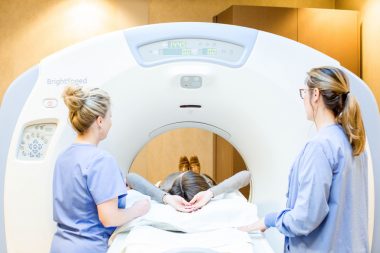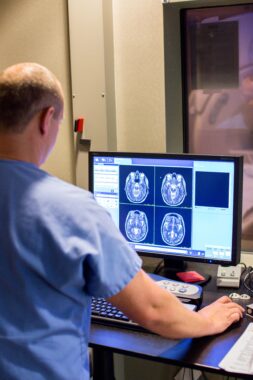Do you spend most of your day sitting and looking at screens? You’re not alone. Thanks to the pandemic, more people than ever are working from home, often sitting for long periods while working at the computer or participating in virtual meetings. If you have neck pain or headaches, the culprit may be the way you hold your head while you are looking at screens — a condition also known as “tech neck.” The good news? Tech neck can often be prevented or reversed by changing your neck and head posture, modifying your workspace, and doing stretching exercises.
Causes and Symptoms of Tech Neck
What is your posture like when you use a desktop computer or look at a handheld device, like a tablet or smartphone? You might find yourself hunching your shoulders, curving your back and tilting your head forward as you look down at the screen. This unnatural position puts strain on your cervical spine – the area where your spinal column meets your neck, affecting the nerves, muscles, tendons, ligaments, and spinal discs in the area.
The stress on your body from this poor posture can cause a variety of symptoms, including:
- Chronic neck pain
- Pain in the shoulders and upper back between the shoulder blades
- Headaches
Over time, tech neck can lead to injury of the discs and vertebrae, and diagnostic imaging may be required to identify the source of the pain.
Read More: What is Your Diagnostic Imaging IQ?
Preventing Tech Neck
Luckily, you can take steps to prevent putting unnecessary strain on your neck while working at a computer or looking at social media on your phone.
- Make sure your chair has good support. Choose a desk chair with lumbar support or place a small pillow at the small of your back.
- Be aware of your posture. Your head weighs about 10 to 12 pounds, but when you let it tilt forward, the pressure on your neck is the equivalent of about 45 pounds. That’s why it’s important to hold it correctly: Sit up straight and make sure your head is aligned directly with your spine, and keep your gaze straight in front of you, instead of down toward the floor. When using a desktop computer, adjust the monitor so it is at eye level. Keep your feet flat on the floor, your elbows close to your body and your shoulders in a relaxed position. If you’re using a handheld device, keep it at eye level by propping it up on pillows or books, and use a case that allows you to angle the phone at an angle for comfortable viewing.
- Get up and move more. Prolonged periods of sitting contribute to neck pain and other health issues. Take a quick break every half hour to stretch and move around.
- Do stretching exercises. Chin tucks can strengthen the muscles that align your head over your shoulders. Stand with your back against a wall, feet shoulder-width apart. Facing forward, tuck your chin down and pull your head back until it rests against the wall. Hold for five seconds and repeat 10 times. Other stretches you can try include shrugging your shoulders up and down and tilting your head to the side while stretching the opposite shoulder downward.
- Exercise regularly. Strengthening your core helps to support your spine and prevent neck and back pain.
Read More: The Differences Between MRI and CT Scans
What to Do if Pain Persists
If your neck and shoulder pain doesn’t go away with posture changes, workspace modifications, and exercise, it could be a sign of something more serious such as degenerative disc disease. This condition is caused by the wearing down of vertebral discs. Your healthcare provider might recommend imaging to determine if there is any damage. At Carolinas Imaging Services, a joint venture between Charlotte Radiology and Atrium Health, our imaging experts provide reliable, convenient services. Your doctors will receive accurate, timely results they can trust.

If an MRI or CT scan reveals signs of disc degeneration, different treatment options are available. These include physical therapy, pain relievers and anti-inflammatory drugs like ibuprofen or naproxen, steroid injections, and, in severe cases, surgery.
Schedule an appointment for diagnostic imaging services at Carolinas Imaging Services or call us at 980-993-7491.



